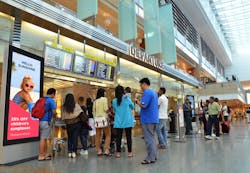Driven by the rising demands from increasingly connected travellers, airport operators have more recently invested heavily in digital technology to improve passenger journeys.
The SITA Airport IT Trends Survey 2016 commissioned by the Airports Council International (ACI), forecast projects an increase in global revenues, pegged at $158 billion by the end of the year. This robust financial picture has allowed for generous budgets allocated for IT investments, with current IT spend likely to exceed $9 billion. Looking ahead to 2017, the global trend for healthy IT investment is expected to continue, with a majority (58 percent) of airport operators’ CIOs anticipating even higher budgets to devote toward improving passenger experience, while 29 percent expect no budget diminution.
Globally, throughout 2016, the majority of airport operators prioritised improving passenger processing as their main IT expenditure, likely to remain the top priority, with two-thirds of airports planning major IT developments in passenger self-service solutions. Over the next three years, 34 percent of airports are also planning major investments in digital technologies such as interactive wayfinding and almost half (48 percent) will be implementing major programs for sensors such as Bluetooth-enabled beacons.
What these priorities in IT spend indicate is that the concept of a “smart airport of the future” is rapidly accelerating into the present and will soon evolve from dizzying concept to everyday reality. As the changes to airport design become evermore hyper-connected and digitally-focused, passengers are anticipated to welcome the increased levels of choice and control that a smart airport can offer:
“What is clear is that once a passenger starts to use self-service technology, such as kiosks, websites or mobile devices, they have a high propensity to continue using self-service rather than returning to human contact for that step of the journey.” – Francesco Violante, CEO of SITA.
In 2016, 85 percent of passengers reported a positive travel experience, (a 5 percent increase from 2015, and after considerable IT investments) with a noticeable rise in positive results where passengers had the most control and choice in their journey (for example, where they could use self-service options for steps such as booking, check-in or getting boarding passes.) Where there are currently limited (or even zero) self-service options (such as security screening, passport control and baggage collection), passengers reported higher levels of negativity.
The Bigger Picture
Although there is undeniably a real need for digital interaction through mobile devices like smartphones, digital solutions on a larger scale will also be able to help shape the smart airport of the future. Digital displays that have been interwoven with various technologies such as beacons and interactive kiosks can help to create a seamlessly integrated passenger journey.
Interactive Kiosks
Interactive kiosks are among the most popular technologies currently available in airports, experiencing high levels of use and positive reviews from travellers. Throughout 2016, 57 percent of passengers used kiosks to check-in, 18 percent for bag tagging, and 37 percent for boarding and SITA’s latest ‘Airport Trends’ survey revealed that 91 percent of passengers that have used this kind of self-service technology stated that they would do so again during future trips.
However, while passengers are open to the concept of using interactive kiosks for various tasks, the “ease of use” of the kiosk itself is highly important. Kiosks that are easy to operate experience a surge of adoption, with 86 percent of passengers being inclined to take advantage of the services they can provide, so long as the technology is intuitive and simple to operate.
As a digital solution, the flexible nature of interactive kiosks suggests huge potential in the near future for additional services independent of logistics. Currently, only 4 percent of airports globally offer passengers the ability to download digital content from kiosks to their smart devices, but another 26 percent have confirmed plans to provide this service by 2019. This means that, in the near future, passengers can expect to be able to download the latest films straight to their devices, or in-flight magazines, prior to boarding, which suggests their greater use in smart airports of the future.
Beacons and real-time messages
“Beacon technology unlocks a world of opportunity for airports, with a clear view of who passengers are, and where they are in the airport.” – Dave Bakker, SITA president, Europe.
For passengers and airports alike, Bluetooth-enabled beacon technology will become a pivotal tool in designing smart airports. A network of sensor technology will be key in helping airports assist their passengers through crucial points of their journey, with real-time updates and personalized messages helping to soothe passenger pain points and anxieties. Passengers say they are ready to embrace sensor technology. Over 90 percent state that they would like contextually-relevant information regarding flight updates, bag collection updates and wayfinding services delivered straight to their smartphones, while over 60 percent stated that they would actively rely on these services if they were readily available.
Beacon adoption in airports has already gone mainstream – over half of airports expect to be using beacons at check-in, bag-drop, security and in dwell areas by as soon as 2018, and over the next five years, 74 percent of airports plan to trial context-aware, location-based technology. The integration of beacons with digital signage systems can open a whole world of opportunity for airport operators and commercial brands – from targeted ads for premium products as passengers walk through the duty free area, or security procedure reminders as they travel through the airport itself. With all of the options for beacon technology and with the technology itself already available, it is likely that the focus of airport operators will be to consider how the existing technology can be used in relevant and innovative ways.
Not only can beacons be integrated with mobile devices, but beacon technology can also be used in combination with digital signage systems to provide a seamless travel experience for passengers. New York’s JFK Airport has combined beacon technology with digital displays to keep their passengers informed with up-to-date wait times for Security and Border Protection checkpoints; and have even extended use to their indoor taxi queue. The beacon technology is used to anonymously and unobtrusively monitor each passenger’s mobile device as they move through the airport, resulting in accurate predictions for wait times at certain checkpoints. This digital solution also allows airport staff to identify and prevent bottlenecks from escalating before they a reach crisis point, resulting in an overall smoother and more pleasant experience for their passengers. Speaking to SITA, Gert-Jan de Graaff, president and CEO of JFKIAT, said:
“We’re probably reaching 19.5 million passengers this year in total. It’s a big operation, which is why we’re introducing innovations to enhance the operations of the building. This new system will help us manage and eliminate problem spots within the facility, and sharing the processing time with our travellers will provide them with peace of mind, so they may continue to expect a pleasant travel experience. Additionally, data from travellers’ phones could eventually influence future airport design.”
American Airlines is another great example of the use of beacon technology. Using a combination of beacons, digital screens and a mobile app, AAL has sought to personalize the experience of members of their Admiral’s Club. On an opt-in basis, as members of the club approach the lounge, nearby beacons will signal the mobile app, which will ask the passenger if they are planning to enter the lounge. If the passenger says yes, the app then communicates via the beacons with digital screens installed for the lounge attendants, which will alert them that this particular passenger is headed to the lounge. The attendants will be able to see a picture of the passenger before they enter, as well as view relevant key messages to relay, such as flight updates. The overall result of this trio of technology is that the lounge attendants can personally greet the passenger by name as they enter the lounge, and immediately provide any useful or helpful information that they may need. Jason Newton, American Airlines’ director of CRM, described this concept as “seamless access,” and stated that the operator believes it will be an “industry first.”
Wayfinding
For passengers, easy and intuitive wayfinding is one of the most crucial factors feeding into a positive travel experience. As Jim Harding, principal at Gresham Smith and Partners, says, “If the number one goal is customer satisfaction, then wayfinding is huge.” Easy navigation is not only important to passengers, but also to airlines: if passengers arrive too late to their gate due to poor directions and an airline misses their slot for take-off, this is a costly blunder. Digital wayfinding solutions are one of the most flexible solutions available for airport operators, as they can be easily updated and adjusted to reflect real-time situations, including changes in location or flight times. By being able to offer the correct information, at the time it is most needed, airport operators are able to ensure operations are smooth and stress-free, thereby providing a more pleasant experience for all involved. Digital signage also affords the opportunity for targeted content, increasing the opportunity for further revenue. One example is the ability to promote a special offer in nearby restaurants or cafes for passengers if a flight has been delayed.
Interactive wayfinding and identity management through the use of biometrics is a trend is set to gather momentum – 34 percent of airports say they are planning major projects for these initiatives in the near future. Furthermore, real-time assistance that is sent directly to passengers on their mobile devices will be seen in the majority of airports by 2018; with more than half of airlines planning to leverage beacon technology to provide important wayfinding information on a personalised, one-to-one basis.
Baggage Collection
Although digital technology has enabled huge advancements for many passenger processes, baggage collection is still the one point of frustration for many. Baggage collection remains one of the largest barriers to an efficient and streamlined passenger process. Indeed, baggage collection topped the list of mobile services that passengers would use regularly if they had access to them; yet it currently has very little (if any) options available for self-service. Perhaps not coincidentally, baggage collection is also the area where passengers experienced the fewest positive emotions (according to SITA’s latest surveys) and so it seems clear that this touchpoint would benefit significantly from digital technologies.
According to SITA’s survey, 79 percent of respondents said that being able to receive live up-to-date notifications of wait times would significantly improve their experience. Coming in at a close second was the ability to report mishandled baggage (67 percent) and lastly, being able to see baggage collection information such as belt number and wait time (65 percent). These huge numbers indicate that there is a massive demand for digital solutions in this area and digital displays can easily soothe and ease passenger irritation arisen through lack of communication. Vital information such as belt numbers and wait times can be deployed and updated via a system of digital networks as a passenger moves throughout the airport, and mishandled baggage claims could be easily and instantly reported through interactive kiosks.
The Future is Now
Current and upcoming budget commitments to invest in digital technologies help ensure rapid progress when it comes to designing “smart” airports that accommodate the hyper-connected nature of today’s passengers. Passengers and airport operators alike are ready to actively embrace digital technology for all aspects of the travel experience; whether that may be more self-service options to increase speed and fluidity of the passenger journey, to interactive wayfinding or targeted advertising. All of these features mean that the design of future airports will be structured to create journeys that are as seamless and sleek as possible. Although most of the technology revolves around creating a more streamlined passenger experience, with more touchpoints providing information, airports too stand to benefit from these advances, with a higher likelihood of repeat customers and the opportunity for increased revenues through up-sells and targeted advertising. Overall, the more opportunity for digital interaction, the better the experience will be for both operators and passengers. With the majority of airports recognising this, the smart airport of the future is set to very soon become the smart airport of today.
SignStix is a member of the Digital Signage Federation, the only independent, not-for-profit trade organization serving the digital signage industry. The DSF supports and promotes the common business interests of worldwide digital signage, interactive technologies and digital out-of-home network industries. To learn more, go to www.digitalsignagefederation.org
Libby Johnson is a Content Marketing Assistant for SignStix, an award-winning digital engagement platform that allows users to effortlessly create innovative and memorable digital experiences with the click of a button.






